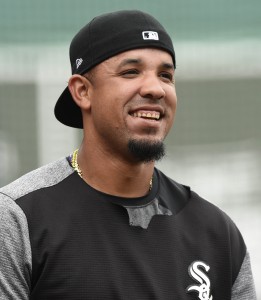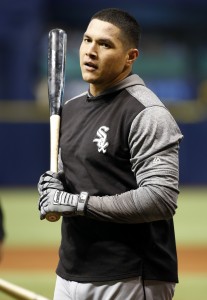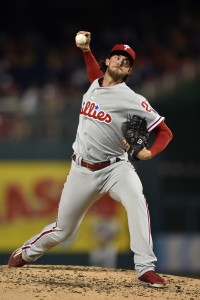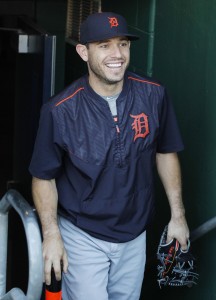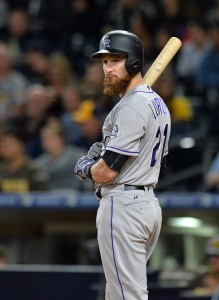MLBTR is publishing Offseason Outlooks for all 30 teams. Click here for the other entries in this series.
The Athletics posted their third straight last-place finish in the American League West in 2017, but for the first time since their fateful Josh Donaldson trade in November 2014, the franchise has a clear direction. Not only did the A’s commit to a full rebuild in the middle of the season, but a couple of their prospective long-term core pieces – first baseman Matt Olson and third baseman Matt Chapman – burst on the scene to provide immediate hope and contribute to a roster that closed the season on a 17-7 run. Led by executive vice president of baseball operations Billy Beane and general manager David Forst, the A’s will continue with a mostly youth-oriented approach in 2018, which means a fairly quiet winter could be in the offing.
Guaranteed Contracts
- Matt Joyce, OF: $6MM through 2018
- Santiago Casilla, RP: $5.5MM through 2018
Contract Options
- Jed Lowrie, IF: $6MM club option or $1MM buyout
Arbitration-Eligible Players (service time in parentheses; projections via Matt Swartz)
- Chris Hatcher (4.146) – $2.2MM
- Khris Davis (4.104) – $11.1MM
- Liam Hendriks (4.038) – $1.9MM
- Marcus Semien (3.118) – $3.2MM
- Josh Phegley (3.114) – $1.1MM
- Blake Treinen (3.065) – $2.3MM
- Jake Smolinski (3.016) – $700K
- Kendall Graveman (3.014) – $2.6MM
- Non-tender candidates: Phegley, Smolinski
Free Agents
- None
Athletics Depth Chart; Athletics Payroll Information
Evidenced by its handful of veteran signings in free agency last offseason, Oakland’s hope was to piece together a roster capable of pushing for a wild-card spot in 2017. But the A’s ended up well out of contention by summertime, paving the way for them to cut ties with several established players, most of whom were on expiring contracts. The primary exceptions were relievers Sean Doolittle and Ryan Madson and starter Sonny Gray, a trio of controllable players whose trades brought back returns which could benefit Oakland for years to come.
Of the A’s top 15 prospects, five came from those deals, per MLBPipeline.com. Doolittle and Madson netted left-hander Jesus Luzardo (No. 5) and third baseman Sheldon Neuse (No. 14) from the Nationals (plus major league reliever Blake Treinen), while Gray’s two-plus years of team control garnered outfielder Dustin Fowler (No. 3), infielder/outfielder Jorge Mateo (No. 4) and righty James Kaprielian (No. 10) from the Yankees.
The Gray deal was especially notable not just for the prospect haul the A’s picked up, but because it was the end result of multiple years of trade rumors centering on the hurler. The A’s orchestrated a weekslong bidding war for Gray before moving him at the non-waiver trade deadline on July 31, and though two of the farmhands they acquired for him are on the mend from significant injuries, they still made out well in the swap. Fowler’s recovering from a ruptured patellar tendon, but the soon-to-be 23-year-old will have a legitimate chance to serve as the A’s starting center fielder from the get-go in 2018, according to Susan Slusser of the San Francisco Chronicle. And Kaprielian, who’s working back from the Tommy John procedure he underwent in April, could enter Oakland’s rotation sometime next year.
The aforementioned prospects are each important pieces of an ascending farm system, one the A’s could further bolster by selling well-performing veterans such as slugger Khris Davis and infielder Jed Lowrie in the coming months. However, they seem inclined to keep the pair. Fresh off his second 40-home run season in a row, Davis has only two years of arbitration control remaining and is projected to earn upward of $11MM in 2018. Despite Davis’ declining control and increasing price tag, A’s brass wants him in the fold.
“He fits in perfectly here,” Beane said after the season, while Forst brushed off concerns about Davis’ rising salary.
“If it is, it is,” Forst said of Davis’ arbitration case potentially being difficult. “I don’t think you could overstate the impact he has on the rest of the lineup.”
Lowrie, meanwhile, is down to his last year of control, but the A’s will pick up his affordable option and write him in as their starting second baseman for 2018. Doing so will allow them to give top prospect Franklin Barreto further seasoning at Triple-A after a rough 2017 debut in the majors, albeit over just 76 plate appearances.
With Davis and Lowrie seemingly returning next year, the majority of the A’s lineup already looks set. The infield will typically feature Olson, Chapman, Lowrie and shortstop Marcus Semien, while Fowler, Davis, Matt Joyce, Boog Powell and Chad Pinder will divvy up most of the reps in the outfield. For now, the designated hitter slot looks as if it’ll primarily belong to corner infielder Ryon Healy, but the A’s could attempt to move him to strengthen their bullpen, according to Slusser. The 25-year-old Healy isn’t even scheduled to reach arbitration until after the 2019 season, which could certainly appeal to teams searching for a long-term offensive piece, though he’s coming off a so-so year at the plate. While Healy belted 25 homers for a team that finished fourth in the majors in long balls (234), his .271/.302/.451 line across 605 PAs hovered around league average, thanks in part to a bottom-of-the-barrel walk rate (3.8). Healy wasn’t much better in that category in his 283-PA rookie year, 2016, when he logged a 4.2 percent mark that a .305/.337/.524 line helped mask.
Regardless of whether Healy sticks around, the A’s will have a chance to build on an offense that placed seventh in the league in wRC+ (102) this year, particularly if they get better production from behind the plate. The A’s catchers, primarily Bruce Maxwell, now-Brewer Stephen Vogt and Josh Phegley, combined to hit just .217/.298/.334 this year. The lefty-swinging Maxwell was the best of the three in 2017 and is likely to collect most of the playing time at catcher next season, but the A’s could at least stand to improve over the righty-hitting Phegley. The 29-year-old non-tender candidate batted a meek .201/.255/.336 in 161 trips to the plate and, like Maxwell, ranked among Baseball Prospectus’ worst pitch framers. Fortunately for Oakland, there will be a few reasonably priced upgrades over Phegley available in free agency, including Chris Iannetta, Nick Hundley and Rene Rivera.
It’s fair to expect the A’s to add a catcher via the open market, but taking that path to find a starting pitcher may not be in the cards.
“The preferred route is to create the pitching staff organically. That’s where we’ve had the most success,” Beane said.
A’s starters ranked 20th in the game in ERA (4.74) and 21st in fWAR (7.9) in 2017, and much of that production came from the departed Gray. Despite that subpar performance, though, the A’s still have a mishmash of 20-something rotation candidates they may prefer to go forward with, including two somewhat established options – Sean Manaea and Kendall Graveman – as well as Jharel Cotton, Andrew Triggs (recovering from hip surgery), Daniel Mengden, Jesse Hahn, Paul Blackburn and Daniel Gossett, among others. There’s also Kaprielian and lefty A.J. Puk, the sixth overall pick in 2016, knocking on the door. But even though Beane isn’t gung-ho on free agency, the A’s could still reel in one of the many soon-to-be available veteran stopgaps capable of eating innings. Notably, only three A’s surpassed 100 frames in 2017.
Oakland’s rotation clearly had problems this season, but the bullpen didn’t help the club’s cause. A’s relievers registered the majors’ sixth-highest ERA (4.57) and ranked just 19th in strikeout percentage (22.0). And remember, that was with Doolittle and Madson around for a large portion of the campaign. Treinen, who came over in that trade, was outstanding for Oakland, though he’s the only returning standout in its relief corps. Santiago Casilla, Ryan Dull, Liam Hendriks, Chris Hatcher and Daniel Coulombe remain controllable for 2018, but nobody from that group was a world-beater this year. So, whether it’s via trade or free agency, it would behoove the A’s to upgrade their bullpen. Beane hasn’t been hesitant to use the market to pick up relievers recently, having added Madson, Casilla and John Axford over the previous two offseasons, and could do so again. Free agency will overflow with possibilities, many of them appealing and affordable. Speculatively, with Coulombe as their only semi-established lefty option, the A’s could look to a southpaw like San Jose native Jake McGee, Brian Duensing, Tony Watson or Fernando Abad for late-game improvement.
Given their new course, any players the A’s go after in free agency during the coming months are likely to be modestly priced Band-Aids, meaning there won’t be another Edwin Encarnacion-type pursuit this winter. Beane noted at his season-ending press conference that the A’s are aiming to take a “disciplined” course in the early stages of their rebuild, revealing that their primary concern is to identify which youngsters are bona fide linchpins worth locking up for the long haul. As such, any lengthy deals the A’s hand out prior to next season are likely to go to players who are already in their organization.


